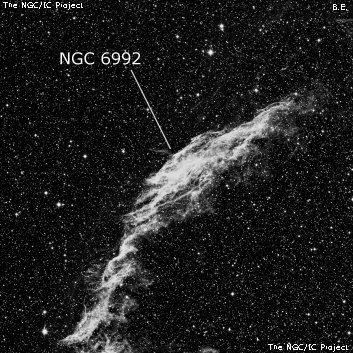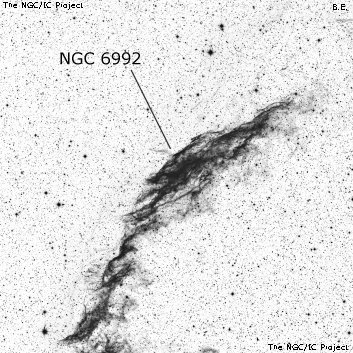NGC/IC Project Restoration Effort
(This is a very very beta version)
NGC6992


Basic Information
Location and Magnitude
Right Ascension: 20:56:18.0
Declination: +31:44:30
Constellation: CYG
Visual Magnitude:
Historic Information
Discoverer: Herschel W.
Year of discovery: 1784
Discovery aperture: 18.7
Observational
Summary description: !!, eF, eL, eE, eiF, bifurcated
Sub-type: SNR
Corwin's Notes
=====
NGC 6992 is part of the Veil Nebula. Given its size, WH's and JH's positions
are surprisingly accordant. The position I've adopted is close to JH's.
Reading WH's published description, I have to wonder if he intended to include
NGC 6960 in his V.14 (i.e. the 14th nebula in his list of "Large Nebulae"):
"Branching nebulosity, extending in RA near 1 1/2 deg., and in PD 52'. The
f[ollowing] part divides into several streams uniting again towards the s."
He did pick up NGC 6960 two nights later as a separate nebula, but the size in
RA that he assigned to NGC 6992 is suggestive that he saw the whole thing on
that first night in September 1784.
See NGC 6960 for further discussion.
Steve's Notes
=====
NGC 6992
17.5" (7/5/86): this section of the Veil nebula is probably the most detailed and exciting emission object to explore in the 17.5" using a 20mm Nagler and OIII filter. Appears very bright, extremely large, very elongated, about 1¡ length, crossed by darker rifts. Feather-like side branches are at the south edge running off towards the west. Breathtaking filamentary detail at 83x is too intricate to describe using an OIII filter particularly on the southern half! The filaments appear like intertwined threads or twisted ropes giving a striking 3-dimensional appearance along the length! Attached to NGC 6995 and IC 1340 to the south.
13" (5/21/82): incredibly detailed at the south edge. Wispy structure with two long tails. Darker rifts and filamentary structure along the entire length.
8": bright at 50x with UHC filter. Some structure seen with darker rifts and branches at the south edge.
15x50 IS binoculars (8/27/11): NGC 6992/6995 is striking at just 15x using a pair of UHC filters threaded over the objectives as a long, curving filament. Although NGC 6960 through 52 Cygni was also visible in the same binocular field, it's is a tougher object, particularly the fainter (forked) southern portion.



